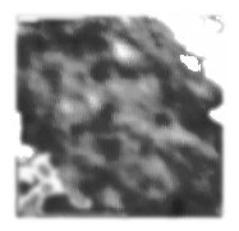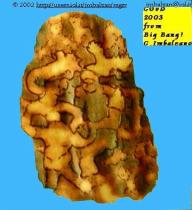


Conferenza al Centro Culturale di Noli
Giovanni Imbalzano
Universe for Life
"Storia delle nostre origini"
<: Theory :>
I) Gas of bosons. For the heavy bosons (with p = mv < mc) the expression of the free energy F = Nm - PV = - PV in absence of upgrades them chemical (m) coincides with that one of the black body (photons with v = c)
dF = - (gVkT/3h3) (4pp2dp) / (ehn/ kT-1) only that the degree of polarisation g=2s+1 (= 3 for Spin s=1) normally is reduced only to gt = 2 in the photons case (for v = c is excluded the longitudinal member, at least for free waves). However, in Relativity a longitudinal polarisation is admitted (spaces them) such that p×A¹0 in presence of loaded electrical workers, associated to the field A0¹0 that satisfies to the condition p×A+p4A4= 0 (space-time gauge). [9] But just the appearance of loaded electrical charges and relative masses demands that the universe was resupplied to its primordial CMBR from a neutral particle complex vector boson (like Z in Electro-weak theory) with various sure speeds from that one of the light (employee from the energy density), in such way that the energy is caught into the matter (pre- or post-inflationary coupling) at least in part. Naturally, far away from the matter the longitudinal field shall assume speed c of the light, and would completely disappear, with a "limit passage" m®0 for the mass to which necessarily it was associated. But we remember that in such case the equation of a wave of Spin s is decomposed in (2s+1) independent equations, of Spin (±)s, (±)(s-1)...0, and only the "additional conditions" eliminate the exceeding members, so that to "the real" photon will remain associated the transversal members Spin (±)s. [10b ] By the Electro-weak theory that means that then the vector boson "it just exchanges" its mass with a Higgs (Spin 0) boson in all similar to the exceeding member.[11] Going again to the primordial gas of complex bosons, it is thought that the processes sufficiently were adiabatic (S entropy constant): the waves in the matter were similar to those sonorous ones. Being
p = hn
/ ui (i = t, l) we consider also various speeds
of phase (ui) for the possible states of polarisation gt =
2, gl = 1, it is supposed that, also in the continuous energetic
exchange between photons and others vector bosons, the cross-sectional waves
contribute in statistical relationship gt/(gt+gl)
= 2/3 to the primary cancellation, and that the same percentage comes then used
from photons. Unless the involved temperatures and factor (2/3) we can refer to Debye
theory for solid bodies (in dispersion absence): [10a] putting
3/
c3 = 2/ut3+1/ul3, Vt
= Vl = V, with ( i = t, l ), Ti = T(c3/ u3)
in the sum
dF = gtdFt+gldFl
= k (2VtT/ut3+VlT/ul3)
(4pn2dn)
/ 3(ehn/
kT-1) = Vk(2Tt/ 3+Tl/
3)(4pn2dn)
/ c3(ehn/kT-1)
the T temperature coincides just with the average Ts = 2Tt/
3+Tl/ 3. From the spectrum two very distinguished peaks will be able
to be found, single in the case in which considerably Vt¹Vl.
They could however be introduced of oscillations
dF/F = dV/V = (Vt
- Vl)/2V = dT/T above all
to H.F. like from the law of Wien T×l =
constant, compatibly with the most recent data experience them (05-10-2002
N.A.S.A.): http://map.gsfc.nasa.gov/m_mm/sg_parameters.html.
II) Observable density. Reducing the amount of effectively reused radiation from photons to percentage (g t / 3) apart from the possible divergences on the choice of a cosmological model and on the effective intensity of the CMBR one obtains the property of "black body" for the universe dFg = g t VkT • (4pn2dn) / 3(e hn / kT - 1) . The relations remain however valid: PV=E/3 = - F, S = - ¶F/ ¶T = 16 sVT 3/ 3c, P = - (¶ F/¶ V)T = 4 sT4/ 3c for which
e = 3PV = 3ST/4, and at least in the adiabatic hypothesis e / T = constant. For the cancellation density it is
r = e / V = 3P = 4s4T/ c, while W l / W t = kTl / 2kTt it represents the relationship of the exchange energies, proportional to the production of real matter (also equipped of charges) or virtual (dark and / or really neutral). And however, remembering
Tt £ Tl : gt / gl ³ WM(obscure) / WM(visible) ³ 2Tt / Tl =1.75. Finally, the maximum observable density rl (Tl4) of energy must be maintained inferior regarding that critic rc (to the advanced limit, would have been transformed in a black hole); we certainly always refer to the values of the cancellation of CMBR to the time of the emission, as today observed. [Fig. III - 9] Similarly, since the density rL relative to the cosmological constant (rL =WLrc) cannot exceed the pressure of observable medium radiation r (Ts4) of the Big Bang (otherwise would go outside from the cone of its light!) from the inequalities rL£r£rl£rc we obtain (Ts / Tl)4 = r / rl³rL / rc = WL with the maximal limit Tl4×WL£ Ts4.
III) Spin interactions. Since 1948, the Landau physicist described to the system between two photons according to a [3x3] matrix spaces composed of antisymmetric / symmetric parts (s) and (a) Aik(p)=sik+aik (i, k = 1...3) determining the values of J moment like in the following columns.
J Be equal (s) Be uneven (a or s)
0: .............. 1 1 (s)
1: .............. 0 0
2k ³ 2: ...... 2 1 (a)
2k+1 ³ 3: .. 1 0
The system respects the classic condition of gauge p×A=0, but it is not present the right Spin (1) that it can come directly described from the classic A(p) carrier; this regarding the reference system can assume values also J>1.[10b ] To the aim of the unification of the fields it is amazing that, from the system to 2 photons, the Spin (2) can be directly obtained of the gravitational tensor gik (symmetrical in indices i, k = 1...4) but not vice versa. Kaluza and Klein come to us in aid with their 5-dimensional gauge theory. By the invariant ds2 = gmndxmdxn (m, n = 1...5) the (A, A4) potential are represented from members gi5 (= 1...4), beyond to the "scalar" field g55 (of sign in agreement with that one of the gravity field). I remember that in the projective version (Weyl-Veblen) the co-ordinates are reduced to 4 (homogenous ones). [12] Finally, for one full equivalence with the previous photons system, would have to be considered a not symmetrical gmn (with real observable values) as it was proposed from Einstein in "the unified" relativity, where the antisymmetric part of gmn is equivalent to the Electromagnetic Field. This, mixed with the gravitational part, concurs to determine the density of field in cosmology in "geometric" way and not more "phenomenological". In any case, the single cosmological equation depends on symmetrical components (as Rik) for which it is necessary to always determine 10 "observable real ones", which the pressure of the matter, 3 speeds, and others 6 elements (symmetrical) of gik. But, to the aim not to banalize the participation of adding the simple matter to "a phenomenological one", is necessary to introduce the gauge transformations (something of similar came perceived from Einstein, with the introduction of the l- invariance that it fuses the asymmetric members with the others); and that concurs the same existence of particles of half-integer Spin (Spinors). [13] The above concurs to assert that necessary and sufficient condition for the Electro-serious unification is the connection of vector bosons with gravitons (Spin the G=2). That can appear banal, but it explains to us why it is not possible to quantize the pure field of gravity: just in the simpler case, with an arbitrary transformation of Lorentz of the "tangent space" the "local members" gik reduce themselves to simple parameters. Vice versa, introducing irreducibly the asymmetric members of Spin (in particular the torsion of Einstein-Cartan) [14, 15] space-time comes subjected to quantic indetermination [16] overcoming the old relativistic determinism.
OBSERVATION. Therefore it is also resolved the paradox of Einstein for which, accepting the quanta theory ingenuously (without integrating it with the gravitation) the perturbations they would carry to indetermination the motion of the Moon without a reasonable tie of cause and effect. Instead, if we associate the "function of wave" of the Moon to the interaction of the asymmetric fields (beyond that from the planetary system) we can ideally go back to the cause of one quantic perturbation (inexplicable from the point of view of the classic mechanics). Sure, the new models of unification, base to you on the Supersymmetry of the Spin, appear very more complicate than the previous ones.
IV) Cosmological hypothesis. As far as the nature and the value of the "constant" WL -and just in sight of the indispensable search of other data it experiences them- I propose what follows. Remembering that for the density relationships the Volume can be considered unitary, in (I) it is introduced the variable (T, ui) that is 2s+1=3 independent members, stating the "black body" characteristics. The 7 previewed lacking members of the 10 in (III) homogeneously represent the characteristic relationship of the density WL » 7/10. Supposing in fact that the residual density of the Big Bang is constituted from the bosons (Spin s=1) associates to gravitons (Spin G=2) by the selection rule J=G±1, they altogether compose the gmn generalised tensor on which the density of cosmological energy depends. For J-= G-1=1 the 3 members described in (I) obtain themselves; for J+= G+1=3, in decomposition with v ® c (m ® 0) ulterior
2J++1=7 members of Spin (±)3, (±)2, (±)1, 0. These last ones constitute the Cartan matrices torsion, gravitation, vector and _ scale torsion (essential ingredients of the Lagrangian of Einstein-Cartan) [14, 15] correspondents to the Yang-Mills & Lorentz Chern-Simon 3-forms, graviton, gauge boson (gluons field) and dilaton of the theories of the 10-dimensional strings. [17] Such members are of attractive type, like g55 (III); in particular, the first two control the expansion and/or contraction of the universe, while the others (Electro-strong) are destined to produce the mass of the quark, as the Electro-weak supplies that one of leptons (I). To the aim to accept such hypotheses, it would be sufficient to confirm the existence of the elevated members of Spin more, the boson "3-sketch" or the fermions (Spin = 3/2, 5/2) associated to Supersymmetry, that they are introduced in the representation of Dirac-Fierz-Pauli. [18] It is observed that the number of the (3) spaces dimensions associated them to the photons is minimal that satisfies not banally to Huygens principle, [19] all the same the "observably" in a Relativistic space-time compel us to superior algebraic representations.
~ G. Imbalzano (TO) October 2002 © MONCALIERI Italy ~ mailto:jmbalzan@iol.it
<: References :>
0] From
Holy Shroud to Big-Bang,
G. Imbalzano, S.S.G.R.R. (Telecom) 2003 L'Aquila
1]
Discussioni sull'origine della vita, A. J. Oparin (e J.
D. Bernal), Boringhieri 1964 Torino
2a,
b]
Le basi biochimiche della vita, F. R. Jevons & Il
caso e la necessità, J. Monod, E.S.T. Mondadori 1970 Milano
3]
La fotosintesi, Asimov, U.S. Boringhieri 1971 Torino
4a,
b]
Il Secondo Principio, P. W. Atkins &
Introduzione all'Astronomia, H. L.
Shipman, Zanichelli 1988 Bologna
BalloonObservationsOfMillimetricExtragalacticRadiationANdGeophysics
papers
5] A flat universe from high-resolution maps of the cosmic microwave background radiation, P. de Bernardis et al, Nature, v404, p955, 2000 (includes figures)
http://www.physics.ucsb.edu/~boomerang/papers/debernardis00.pdf
http://www.physics.ucsb.edu/~boomerang/papers/lange00.pdf
6] Measurement of a Peak in the Cosmic Microwave Background Power Spectrum from the Test Flight of Boomerang, P. Mauskopf et al, Ap. J. Letters, 536, L59, (2000). (Astro-ph/9911444) http://www.physics.ucsb.edu/~boomerang/papers/b97_pspec_9911444.pdf
7]
A Measurement of
Omega From the Boomerang 1997 Test Flight,
A. Melchiorri et al, Ap. J. Letters, 536, L63, (2000). (Astro-ph/9911445)
http://www.physics.ucsb.edu/~boomerang/papers/b97_interp_9911445.pdf
Theses
8]
A Measurement of the
Angular Power Spectrum of the Cosmic Microwave Background with a Long Duration
Balloon-borne Receiver, Brendan Crill, California Institute of Technology, Nov. 2000 http://www.physics.ucsb.edu/~boomerang/papers/bpc_thesis.pdf
Literature
9]
The Principles of
Quantum Mechanics,
P.A.M. Dirac, Clarendon 1958 Oxford
10a,
b] Physique
Statistique & Théorie
Quantique Relativiste, L. Landau & E. Lifshitz, MIR 1967 & 1972
Moscou
11]
Gauge
Theory of Weak Interactions,
W. Greiner & B. Muller, Springer-Verlag 1933 Heidelberg
12] Teoria della Relatività, W. Pauli, Boringhieri 1958 Torino
13] Effective Lagrangians for the Standard Model, A. Dobado, A. Gòmez-Nicola, A. L. Marotto, J. R. Pel\'e0ez, Springer-Verlag 1997 New York
14] Sur
le varietées
à connection affine, E. Cartan, Gauthiers-Villars 1955 Paris
15]
Gauge
Theory of Gravity and Supergravity on a Group Manifold,
Y. Ne'eman T. Regge, La Rivista del Nuovo Cimento 1978 Bologna
16]
B. K. Datta, V. de Sabbata, L. Ronchetti, Il Nuovo Cimento 113B (711) 1998 Bologna; Gravitation
and Modern Cosmology, V. de Sabbata Plenum Press 1991 New York
17]
Unification and Supersymmetry, R. N.
Mohapatra, Springer-Verlag 1996 New York
18]
Theory of Elementary
Particles, P.
Roman, North-Holland P. C. 1964 Amsterdam
19] Equazioni a derivate parziali, F. G. Tricomi, Cremonese Ed. 1957 Roma
20] Eidologia informatica, P. Morasso & V. Tagliasco, N.I.S. 1984 Roma
http://users.iol.it/jmbalzan/ssgrr/index.htm
Figures
and WEB pages
21]
Big
Bang "BOOMERAnG"
I.N.F.N. Rome, Italy http://oberon.roma1.infn.it/boomerang/pressrelease/illustrations
22] G. Imbalzano on Physics http://users.iol.it/jmbalzan/physics.htm
GLOBE
Project [Global Learning Observations Benefit Environment] http://users.iol.it/jmbalzan/majog.htm
[cfr. http://globe.fsl.noaa.gov/
]
23] G. Imbalzano
"The eyes of the Big Bang" :
http://users.iol.it/jmbalzan/selecti2.htm
- Orange & White http://users.iol.it/jmbalzan/chredbig.htm
- First SOUND:
http://users.iol.it/jmbalzan/rbigfak2.zip
24] G. Imbalzano "The eyes of the
Holy-Shroud" : http://users.iol.it/jmbalzan/sindone.htm
25] Un metodo chemio-termografico di stampa ad effetti tridimensionali (II
Convegno Nazionale di Sindonologia) 1981 La Sindone Scienza e Fede BOLOGNA
C.L.U.E.B.
26] Il linguaggio della Sindone I-II 1980-1981 TORINO "SINDON" Rivista
C.I.S.
27] Missaggio della Sindone (III Congresso Nazionale 1985) LA SINDONE
(Nuovi Studi e Ricerche) 1986 MILANO Ed. Paoline
28] Il C14 e la preistoria della Sindone (V Congresso Nazionale) 1990
CAGLIARI La datazione della Sindone Regione Autonoma Sardegna
29] Duplicità del Volto Sindonico (III Congresso Internazionale) Giugno
1998 TORINO Centro Internazionale di Sindonologia http://users.iol.it/jmbalzan/sindoub2.doc
Religion:
30]
Arc. S. Baldassarri, Rabb. E. Toaff, Patr. E. Atenagora & Frère M.
Thurian, La Bibbia Concordata Mondadori 1968 RAVENNA.
\ Sulla questione della CP-violazione, tesi di laurea, Università di Torino 1967;
\ Introduzione relativistica con metodi geometrici elementari, dal Bollettino n.106 del LXI Congresso Nazionale della Societ\'e0 Italiana di Fisica, Bologna, Ed.Compositori 1975;
\ Introduzione quantistica con metodi algebrici elementari, dal Bollettino n.106 del LXI Congresso Nazionale della Societ\'e0 Italiana di Fisica, Bologna, Ed.Compositori 1975;
\ Massa delle particelle e del muone in SU6, comunicazione interna per la Scuola di Specializzazione in Fisica Nucleare, Torino 1978;
\ Riflessioni sull'Ultimo Teorema di Fermat, Torino, Ed.A.G.A.T. 1988;
\ Riconferma dell'Ultimo teorema di Fermat (e algebra dell'eptadecagono regolare), XXXV Congresso Nazionale Associazione per l'Insegnamento della Fisica, 25/10/1996 ("Atti" in La Fisica nella scuola, anno XXXI n.1, Supplemento del gennaio-marzo 1998);
\ La struttura fine è una costante termodinamica? XXXV Congresso Nazionale A.I.F. 25/10/1996 ("Fisica statistica e costante di struttura fine" "Atti" c.s.);
\ Costanti adimensionali e nuova fisica (Primavera 1998) in INTERNET:
http://users.iol.it/jmbalzan/physics.htm
Alla voce SINDONOLOGY,
di quest'ultimo sito, si trovano anche gli "estratti"
degli articoli sulla S. Sindone e, rispettivamente alle voci MATHEMATICS
& PHYSICS, si trovano i riassunti
dei lavori relativi a tali discipline. Una
selezione di POESIE dello stesso autore a cui egli si era dedicato fin dagli
anni Cinquanta si trovano su:
http://users.iol.it/jmbalzan/lyricae.htm
Laureato in Fisica (teorica) all'Università di Torino (1967)
Insegnante di Matematica e Fisica (con Informatica)
Formatore per il P.N.I. (Piano Nazionale per l'Informatica)
Docente guida (GLOBE teacher) per il progetto G.L.O.B.E. (Global Learning and Observations to Benefit Environment) sotto l'egida degli Enti spaziali N.O.A.A. (National Oceanic and Atmospheric Administration) & N.A.S.A. (National Aeronautics and Space Administration)
Rappresentante italiano e premiato per il progetto W.S.W. (World Space Week) quale "Insegnante dell'anno" per le Scuole Superiori del progetto, sotto l'egida dell'ONU
Sindonologo riconosciuto dal C.I.S. (Centro Sindonologico Internazionale) di Torino
Nato nel 1944, è sposato, padre di due figlie e nonno.
Prof.
G. Imbalzano,
Moncalieri
jmbalzan@iol.it


